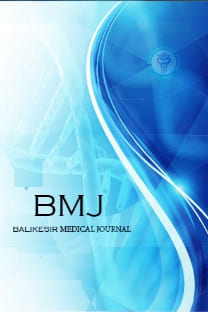Normal erkek fenotipe sahip 45, X/46, XY kromozomal mosaizm ve azoospermisi olan infertil hasta
An infertile patient who had normal male phenotype with 45,X/46,XY chromosomal mosaicism and azoospermia
azoospermia, mozaisim, turner,
___
- 1. Lippe B. Turner syndrome. Endocrinol Metab Clin North Am 1991;20:121-52.
- 2. Cunniff C. Turner syndrome. Adolesc Med 2002;13:359-66.
- 3. Elsheikh M, Dunger DB, Conway GS, Wass JA. Turner’s syndrome in adulthood. Endocr Rev 2002;23:120-40.
- 4. Ogata T, Matsuo N. Turner syndrome and female sex chromosome aberrations: deduction of the principal factors involved in the development of clinical features. Hum Genet 1995;95:607-29.
- 5. Stratakis CA, Rennert OM. Turner syndrome: molecular and cytogenetics, dismorphology, endocrine and clinical manifestations and their manegement. Endokrinologist 1994;4: 442-53.
- 6. Sybert VP, McCauley E. Turner’s syndrome. N Engl J Med 2004;351:1227-38.
- 7. Siegel DH, Sybert VP. Understanding aneuploidy. Pediatr Dermatol 2005;22:270-5.
- 8. Kim ED, Bischoff FZ, Lipshultz LkI, Lamb DJ. Genetic concerns for the subfertile male in the era of ICSI. Prenat Diagn 1998;18:1349–65.
- 9. Niederberger C. Genetic abnormalities among severely oligospermic men who are candidates for intracytoplasmic sperm injection. J Urol 2005;174:1046–7.
- 10. Telvi L, Lebbar A, Del Pino O, Barbet JP, Chaussain JL. 45,X/46,XY mosaicism: report of 27 cases. Pediatrics 1999; 104:304–8.
- 11. Aranoff GS, Morishima A. XO/XY mosaicism in delayed puberty. J Adolesc Health Care 1988;9:501–4.
- Yayın Aralığı: Yıllık
- Başlangıç: 2017
- Yayıncı: Balıkesir Üniversitesi
Mehmet Burak Özkan, Meltem Ceyhan Bilgici, Eser Turgut
Bruton hastalığı zemininde gelişen PML olgusuna pediatrik radyoloji açısından bakış
Mehmet Burak OZKAN, Meltem CEYHAN BİLGİCİ, Alişan YİLDİRAN
Normal erkek fenotipe sahip 45, X/46, XY kromozomal mosaizm ve azoospermisi olan infertil hasta
Erkan ERDEM, Akın USTA, Eren ALTUN, Meriç KARACAN
BALIKESİR İLİNDEKİ KOLOREKTAL POLİPEKTOMİ OLGULARININ DEĞERLENDİRİLMESİ
Figen ASLAN, Gülay TURAN, Eren ALTUN
Mehmet burak Ozkan, Meltem Ceyhan bilgici
Palyatif Bakımda Onikomikoz ve Hiperkeratoz Birlikteliği Görülen Bir Olgu Sunumu
Ali Ramazan BENLİ, Cansu KAVRUT, Cansu ŞERİFOĞLU, Alpay AKTÜMEN, Süleyman ERSOY, Didem ADAHAN
İNTRAOPERATİF KONSÜLTASYONUN MEME CERRAHİSİ VE SENTİNEL LENF NODU BİYOPSİSİNDEKİ ÖNEMİ
Ferah TUNCEL DALOĞLU, Emre Çağatay KÖSE, Ahmet DAĞ
ORAL ANTİDİYABETİK PİOGLİTAZONUN KARACİĞER KANSERİ ÜZERİNE ETKİSİ
